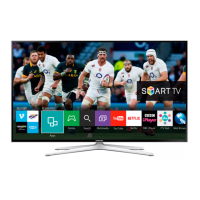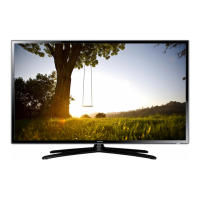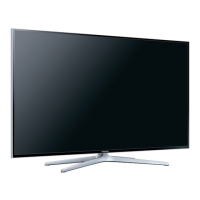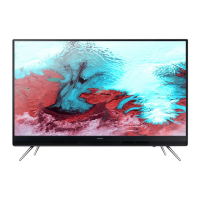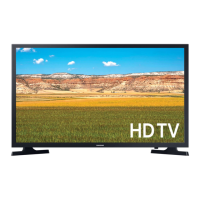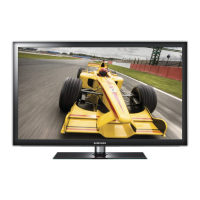Do you have a question about the Samsung UE32J5100 and is the answer not in the manual?
Connect to the internet and set up Smart Hub for optimal use.
Operate the TV using the pointer button and directional controls.
Rearrange, rename, and delete channels from the channel list.
Establish wired or wireless internet connections for network access.
Connect external video sources like Blu-ray players using HDMI or component cables.
Use the TV as a computer monitor via HDMI or home network.
Overview of the Samsung Smart Control remote.
Detailed operations of the Samsung Smart Control for TV interaction.
Surf the web, download apps, and enjoy multimedia content.
Create, sign in, and link Samsung accounts for enhanced features.
Download and play games through the TV's gaming service.
Check programme lineups, current info, and signal strength.
Record current or upcoming programmes for later viewing.
Optimize picture settings like brightness, contrast, and colour.
Select sound modes and apply effects for optimal audio experience.
Set the TV's clock and use sleep or on timers for convenience.
Update TV software via internet or USB for latest features.
Find solutions for common TV problems and issues.
Guidelines and limitations for using applications on the TV.
Notes and restrictions for using the TV's built-in web browser.
Access the function to manage channels.
Change channel order or remove channels from the list.
Connect the TV to the internet using LAN cables.
Connect the TV to a wireless network using Wi-Fi.
Connect video sources using HDMI cables for best quality.
Use HDMI ARC for audio return channel functionality.
Connect a computer to the TV using the HDMI port.
Display mobile device screen via MHL-to-HDMI connection.
Wirelessly mirror mobile device screen onto the TV.
Important notes regarding HDMI cable usage and compatibility.
Control the TV interface using the pointer functionality.
Navigate menus and select options using standard buttons.
Connect USB or Bluetooth keyboards for enhanced input.
Connect a USB mouse for pointer control.
Basic operations for controlling the TV with a mouse.
Navigate and utilize the Smart Hub interface and features.
Restore Smart Hub settings to factory defaults.
Set up a Samsung account for accessing services.
Install and launch games from the TV's service.
Manage installed apps using options menu.
Quickly install applications from the available list.
Access the TV's embedded electronic manual.
Configure settings for web browsing experience.
Play media files from connected storage devices.
Access the programme guide for channel lineups and details.
Start recording the current programme immediately.
Schedule future channel viewings for convenience.
Add channels to custom favourites lists for quick access.
Activate sports mode for optimized picture and sound settings.
Scan for channels manually when automatic tuning fails.
Select optimal picture modes like Dynamic, Standard, or Movie.
Select sound modes like Standard, Music, or Movie for enhanced audio.
Connect and use Bluetooth audio devices with the TV.
Manually set the TV's current time and date.
Adjust brightness and use eco solutions to save power.
Enable and configure Anynet+ for controlling connected devices.
Update TV software via internet or USB for latest features.
Scan TV and media for malware.
Increase font size for better readability for visually impaired users.
Enable simultaneous TV and Bluetooth headphone audio.
Connect the CI/CI+ card to the common interface slot.
Allow remote diagnostics and repair by Samsung technicians.
Run the picture test to diagnose display issues.
Run the sound test to diagnose audio issues.
Troubleshoot unsupported resolution messages.
Troubleshoot wireless network connection problems.
Reset all TV settings to factory defaults.
Prerequisites and recommendations before using recording features.
Understand limitations for playing media files.
Understand limitations when using the PIP feature.
Compatibility of picture sizes with different input signals.
Supported wireless network security protocols for connection.
Supported display resolutions for IBM PCs.
Supported display resolutions according to VESA DMT standards.
Supported display resolutions according to CEA-861 standards.
Understand limitations and potential issues with Bluetooth devices.
Definitions of video resolution terms like 480i, 480p, 720p, 1080i, 1080p.
Definition of HDMI and its function for transmitting signals.
Explanation of component connections for video signal transmission.
Connect to the internet and set up Smart Hub for optimal use.
Operate the TV using the pointer button and directional controls.
Rearrange, rename, and delete channels from the channel list.
Establish wired or wireless internet connections for network access.
Connect external video sources like Blu-ray players using HDMI or component cables.
Use the TV as a computer monitor via HDMI or home network.
Overview of the Samsung Smart Control remote.
Detailed operations of the Samsung Smart Control for TV interaction.
Surf the web, download apps, and enjoy multimedia content.
Create, sign in, and link Samsung accounts for enhanced features.
Download and play games through the TV's gaming service.
Check programme lineups, current info, and signal strength.
Record current or upcoming programmes for later viewing.
Optimize picture settings like brightness, contrast, and colour.
Select sound modes and apply effects for optimal audio experience.
Set the TV's clock and use sleep or on timers for convenience.
Update TV software via internet or USB for latest features.
Find solutions for common TV problems and issues.
Guidelines and limitations for using applications on the TV.
Notes and restrictions for using the TV's built-in web browser.
Access the function to manage channels.
Change channel order or remove channels from the list.
Connect the TV to the internet using LAN cables.
Connect the TV to a wireless network using Wi-Fi.
Connect video sources using HDMI cables for best quality.
Use HDMI ARC for audio return channel functionality.
Connect a computer to the TV using the HDMI port.
Display mobile device screen via MHL-to-HDMI connection.
Wirelessly mirror mobile device screen onto the TV.
Important notes regarding HDMI cable usage and compatibility.
Control the TV interface using the pointer functionality.
Navigate menus and select options using standard buttons.
Connect USB or Bluetooth keyboards for enhanced input.
Connect a USB mouse for pointer control.
Basic operations for controlling the TV with a mouse.
Navigate and utilize the Smart Hub interface and features.
Restore Smart Hub settings to factory defaults.
Set up a Samsung account for accessing services.
Install and launch games from the TV's service.
Manage installed apps using options menu.
Quickly install applications from the available list.
Access the TV's embedded electronic manual.
Configure settings for web browsing experience.
Play media files from connected storage devices.
Access the programme guide for channel lineups and details.
Start recording the current programme immediately.
Schedule future channel viewings for convenience.
Add channels to custom favourites lists for quick access.
Activate sports mode for optimized picture and sound settings.
Scan for channels manually when automatic tuning fails.
Select optimal picture modes like Dynamic, Standard, or Movie.
Select sound modes like Standard, Music, or Movie for enhanced audio.
Connect and use Bluetooth audio devices with the TV.
Manually set the TV's current time and date.
Adjust brightness and use eco solutions to save power.
Enable and configure Anynet+ for controlling connected devices.
Update TV software via internet or USB for latest features.
Scan TV and media for malware.
Increase font size for better readability for visually impaired users.
Enable simultaneous TV and Bluetooth headphone audio.
Connect the CI/CI+ card to the common interface slot.
Allow remote diagnostics and repair by Samsung technicians.
Run the picture test to diagnose display issues.
Run the sound test to diagnose audio issues.
Troubleshoot unsupported resolution messages.
Troubleshoot wireless network connection problems.
Reset all TV settings to factory defaults.
Prerequisites and recommendations before using recording features.
Understand limitations for playing media files.
Understand limitations when using the PIP feature.
Compatibility of picture sizes with different input signals.
Supported wireless network security protocols for connection.
Supported display resolutions for IBM PCs.
Supported display resolutions according to VESA DMT standards.
Supported display resolutions according to CEA-861 standards.
Understand limitations and potential issues with Bluetooth devices.
Definitions of video resolution terms like 480i, 480p, 720p, 1080i, 1080p.
Definition of HDMI and its function for transmitting signals.
Explanation of component connections for video signal transmission.
| Screen shape | Flat |
|---|---|
| Response time | - ms |
| Display diagonal | 32 \ |
| Display brightness | - cd/m² |
| Native aspect ratio | 16:9 |
| LED backlighting type | - |
| Supported video modes | 1080p |
| Display diagonal (metric) | 80 cm |
| Supported graphics resolutions | 1920 x 1080 (HD 1080) |
| Motion interpolation technology | PQI (Picture Quality Index) 200 |
| Dynamic contrast ratio marketing name | Mega Contrast |
| 3D | No |
| Annual energy consumption | 45 kWh |
| Digital signal format system | DVB-C, DVB-T |
| Audio decoders | Dolby Digital, Dolby Digital Plus |
| RMS rated power | 20 W |
| Number of speakers | 2 |
| DVI-D ports quantity | 0 |
| USB 2.0 ports quantity | 1 |
| Number of OSD languages | 27 |
| Picture processing technology | Samsung Wide Color Enhancer |
| Product color | Black, Silver |
| Panel mounting interface | 200 x 200 mm |
| AC input voltage | 220 - 240 V |
| Power consumption (max) | 64 W |
| Power consumption (standby) | - W |
| Power consumption (typical) | 31 W |
| Package depth | 127 mm |
| Package width | 901 mm |
| Package height | 522 mm |
| Package weight | 6800 g |
| Cables included | AC |
| Depth (with stand) | 207.5 mm |
|---|---|
| Height (with stand) | 473.9 mm |
| Weight (with stand) | 5300 g |
| Depth (without stand) | 64.6 mm |
| Width (without stand) | 723 mm |
| Height (without stand) | 427.5 mm |
| Weight (without stand) | 4900 g |
